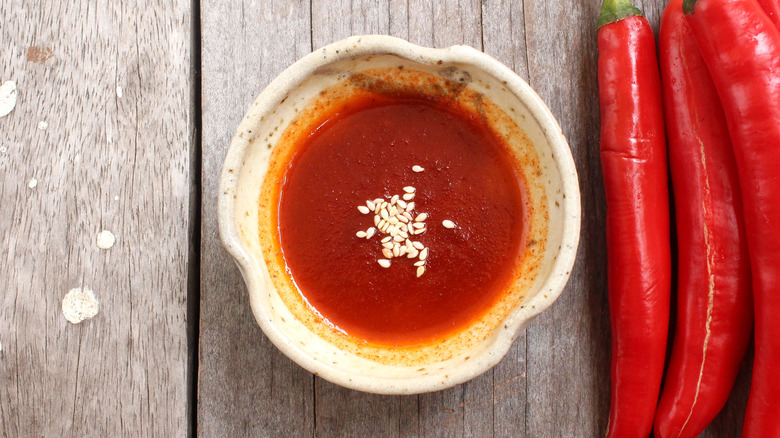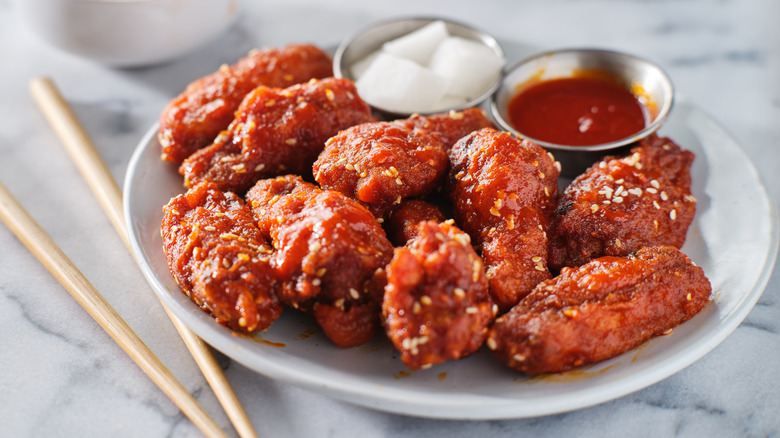The Gochujang-Packed Sauce That'll Add A Spicy Tang To Any Meal
Gochujang is an essential cooking sauce for anyone wishing to explore the foundational flavors of Korean cuisine. It's got this super punchy, spicy taste that's salty, deeply savory, and slightly funky. The fermented red pepper condiment is often used for seasoning, as a sauce on tteokbokki (spicy rice cakes), and dolloped on top of bibimbap rice bowls. Gochujang can be considered one of the pinnacles of Korean cooking thanks to its versatility, especially as the base for other sauces that deftly accentuate specific flavors. Chogochujang is one of these sauces, and it's brimming with a unique spice and vinegary tang that's perfect for just about any meal.
Chogochujang also boasts umami notes that bring out the sweeter side of the gochujang (umami being the fifth taste that represents a deep savoriness and richness that's distinct from saltiness). It's a sauce that delivers on all fronts flavorwise and also packs a noticeable tongue-tingling bite. Simple to make, it's an easy yet impactful addition that will elevate all kinds of dishes.
Spice it up
Chogochujang is incredibly easy to whip up. In its more basic form, it can be made with a mixture of vinegar and gochujang. However, for a slightly sweeter chogochujang, you can add sugar too. Other common ingredients added to the sauce are white wine vinegar, minced garlic, and whole sesame seeds. Mix these all together in a bowl, and you're good to go. Freshly made chogochujang will keep in the fridge for a week. While you can substitute white wine vinegar for cider vinegar, it is not recommended to use gochugaru as a replacement for gochujang. Apart from their shared spiciness, they are incredibly different in taste and texture.
If you want to adventure further, consider adding a little honey to the chogochujang or, if you can find it, a tablespoon of plum juice or syrup. The best aspect of this sauce is that it can be adjusted depending on how garlicky, sweet, or spicy you want. If gochujang alone usually raises your eyebrows, then you'll be happy to learn that chogochujang can be mixed into mayonnaise for a cooler yet still delightfully flavorful dip.
Chogochujang is the spice of life
Chogochujang can be used in various Korean dishes, but one place it really shines is with seafood. In particular, chogochujang is a spectacular dipping sauce for sashimi. The pairing of spicy, tangy sweetness with fresh raw fish is thought to be totally moreish. Yet, there is some debate about the vinegar in chogochujang and whether it can be overpowering, especially in contrast to the delicate flavors of the fish. If you're apprehensive about this, go easy on the vinegar when creating your sauce.
Chogochujang can be added to your favorite Korean dishes instead of gochujang, too, like bibimbap and jjigae (stews). It's also commonly used as a dipping sauce for pickled or fresh vegetables, kelp, or seaweed. Other ideas include using the sauce as a marinade, as a glaze for meats or vegetables over the grill, or to coat some crispy chicken wings. If you want to delve deeper into Korean flavors, chogochujang is a fantastic place to start; it'll pack some serious spicy-sweet flavor into any dish.


